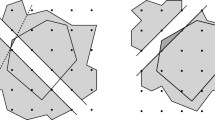Abstract
The reformulation–linearization technique, due to Sherali and Adams, can be used to construct hierarchies of linear programming relaxations of mixed 0–1 polynomial programs. As one moves up the hierarchy, the relaxations grow stronger, but the number of variables increases exponentially. We present a procedure that generates cutting planes at any given level of the hierarchy, by optimally weakening linear inequalities that are valid at any given higher level. Computational experiments, conducted on instances of the quadratic knapsack problem, indicate that the cutting planes can close a significant proportion of the integrality gap.
Similar content being viewed by others
References
Adams, W.P., Guignard, M., Hahn, P.M., Hightower, W.L.: A level-2 reformulation–linearization technique bound for the quadratic assignment problem. Eur. J. Oper. Res. 180, 983–996 (2007)
Barahona, F., Jünger, M., Reinelt, G.: Experiments in quadratic 0–1 programming. Math. Program. 44, 127–137 (1989)
Billionnet, A., Calmels, F.: Linear programming for the 0–1 quadratic knapsack problem. Eur. J. Oper. Res. 92, 310–325 (1996)
Bonami, P., Minoux, M.: Using rank-1 lift-and-project closures to generate cuts for 0–1 MIPs, a computational investigation. Discrete Optim. 2, 288–307 (2005)
Caprara, A., Pisinger, D., Toth, P.: Exact solution of the quadratic knapsack problem. INFORMS J. Comput. 11, 125–137 (1998)
Christof, T., Loebl, A.: PORTA (polyhedron representation transformation algorithm). Software package, available for download at http://www.iwr.uni-heidelberg.de/groups/comopt/software
Floudas, C.A.: Deterministic Global Optimization: Theory, Algorithms and Applications. Kluwer, Dordrecht (1999)
Fukuda, K.: cdd (C double description program). Software package, available for download at: http://www.cs.mcgill.ca/~fukuda/soft/cdd_home
Gallo, G., Hammer, P.L., Simeone, B.: Quadratic knapsack problems. Math. Program. Stud. 12, 132–149 (1980)
Grötschel, M., Lovász, L., Schrijver, A.J.: Geometric Algorithms and Combinatorial Optimization. Springer, Berlin (1988)
Hahn, P.M., Zhu, Y.-R., Guignard, M., Hightower, W.L., Saltzman, M.J.: A level-3 reformulation–linearization technique-based bound for the quadratic assignment problem. INFORMS J. Comput. 24, 202–209 (2012)
Helmberg, C., Rendl, F.: Solving quadratic (0, 1)-programs by semidefinite programs and cutting planes. Math. Program. 82, 291–315 (1998)
Hunting, M., Faigle, U., Kern, W.: A Lagrangean relaxation approach to the edge-weighted clique problem. Eur. J. Oper. Res. 131, 119–131 (2001)
Lasserre, J.B.: Global optimization with polynomials and the problem of moments. SIAM J. Optim. 11, 796–817 (2001)
Lovász, L., Schrijver, A.J.: Cones of matrices and set-functions and 0–1 optimization. SIAM J. Optim. 1, 166–190 (1991)
Padberg, M.W.: The Boolean quadric polytope: some characteristics, facets and relatives. Math. Program. 45, 139–172 (1989)
Parrilo, P.A.: Semidefinite programming relaxations for semialgebraic problems. Math. Program. 96, 293–320 (2003)
Pisinger, D.: The quadratic knapsack problem—a survey. Discrete Appl. Math. 155, 623–648 (2007)
Saito, H., Fujie, T., Matsui, T., Matuura, S.: A study of the quadratic semi-assignment polytope. Discrete Optim. 6, 37–50 (2009)
Sherali, H.D., Adams, W.: A hierarchy of relaxations between the continuous and convex hull representations for 0–1 programming problems. SIAM J. Discrete Math. 3, 411–430 (1990)
Sherali, H.D., Tuncbilek, C.H.: A global optimization algorithm for polynomial programming problems using a reformulation–linearization technique. J. Glob. Optim. 2, 101–112 (1992)
Sherali, H.D., Adams, W.P.: A hierarchy of relaxations and convex hull characterizations for mixed-integer zero-one programming problems. Discrete Appl. Math. 52, 83–106 (1994)
Sherali, H.D., Lee, Y.: Tighter representations for set partitioning problems. Discrete Appl. Math. 68, 153–167 (1996)
Sherali, H.D., Adams, W.P.: A Reformulation-Linearization Technique for Solving Discrete and Continuous Nonconvex Problems. Kluwer, Dordrecht (1998)
Sherali, H.D.: RLT: A unified approach for discrete and continuous nonconvex optimization. Ann. Oper. Res. 149, 185–193 (2007)
Tawarmalani, M., Sahinidis, N.V.: Convexification and Global Optimization in Continuous and Mixed-Integer Nonlinear Programming. Kluwer, Dortrecht (2003)
Yajima, Y., Fujie, T.: A polyhedral approach for nonconvex quadratic programming problems with box constraints. J. Glob. Optim. 13, 151–170 (1998)
Acknowledgments
We are grateful to the late Alberto Caprara for giving us his QKP code. Thanks are also due to two anonymous referees for several helpful comments and suggestions.
Author information
Authors and Affiliations
Corresponding author
Rights and permissions
About this article
Cite this article
Fomeni, F.D., Kaparis, K. & Letchford, A.N. Cutting planes for RLT relaxations of mixed 0–1 polynomial programs. Math. Program. 151, 639–658 (2015). https://doi.org/10.1007/s10107-015-0863-8
Received:
Accepted:
Published:
Issue Date:
DOI: https://doi.org/10.1007/s10107-015-0863-8




